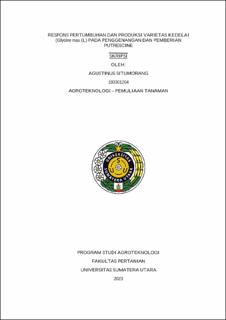Respons Pertumbuhan dan Produksi Varietas Kedelai (Glycine Max (L) pada Penggenangan dan Pemberian Putrescine
Growth and Production Response of Soybean Varieties (Glyicine max (L.) Merr.) at Waterlogging and Applying of Putrescine

Date
2023Author
Situmorang, Agustinus
Advisor(s)
Damanik, Revandy Iskandar Muda
Metadata
Show full item recordAbstract
This research aims to determine whether the use of putrescine on soybean
plants against waterlogging stress can increase soybean production. This research
was carried out from May to August 2023 using Split Split Plot Design. The factor
consists of 3 treatments, namely: (V) Varieties consisting of the Agromulyo (V1),
Deja 2 (V2) and Dering 2 (V3). (T) Putrescine consists of control (T0) and 150ppm
(T1) and (G) Puddling stress consists of control (G0) and 50% puddling (G1). Data
were analyzed using Analysis of Variance (ANOVA) for each parameter measured
and further tested for real treatments using the Duncan Multiple Range Test
(DMRT) at the 5% level. The parameters observed were plant height, number of
leaves, stem diameter, flowering time, number of pods per plant, number of filled
pods, number of empty pods, and seed weight. The results showed that the
combination of the three treatments, namely, variety, putrescine concentration and
waterlogging, had a significant effect on soybean plant height at 3 WAP, variety
had a significant effect on plant height at 4 and 5 WAP, number of leaves at 1 and
2 WAP, stem diameter at 1 WAP. and flowering age, waterlogging stress had a
significant effect on plant height at 5 WAP, number of leaves at 6 WAP, flowering
age, number of pods per plant, number of filled pods, and seed weight per plant,
putrescine had a significant effect on number of pods per plant, number of pods.
contains and weight of soybean seeds.
Collections
- Undergraduate Theses [3389]
